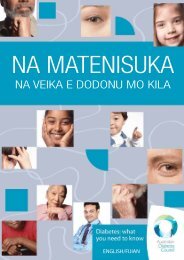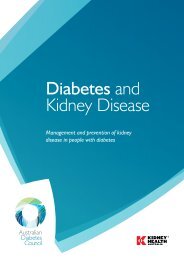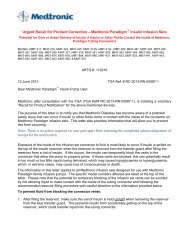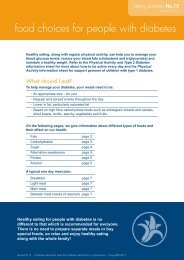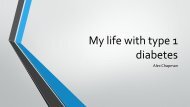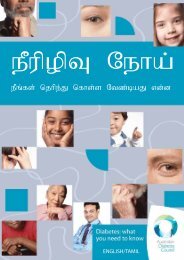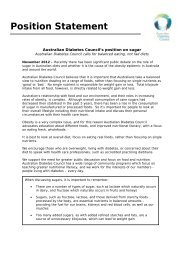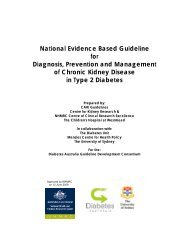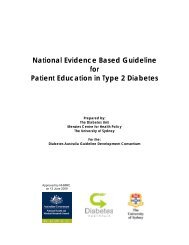O MeA e tAtAU OnA e IlOA - Australian Diabetes Council
O MeA e tAtAU OnA e IlOA - Australian Diabetes Council
O MeA e tAtAU OnA e IlOA - Australian Diabetes Council
Create successful ePaper yourself
Turn your PDF publications into a flip-book with our unique Google optimized e-Paper software.
1<br />
2<br />
What is diabetes?<br />
<strong>Diabetes</strong> is a condition where the amount of glucose (sugar) in the blood is too high.<br />
Glucose is your body’s main energy source but when blood glucose is too high over long<br />
periods it can damage certain organs.<br />
Glucose comes from carbohydrate foods that are broken down and released into the<br />
bloodstream. Carbohydrate foods include bread, rice, potatoes, fruit and milk.<br />
The pancreas, a part of the body that is found behind the stomach, releases a hormone<br />
called insulin into the blood stream. Insulin allows the glucose to move from the blood<br />
stream into certain cells of the body, where it is changed into energy. We use this energy to<br />
walk, talk, think, and carry out many other activities.<br />
<strong>Diabetes</strong> occurs when there is either no insulin, not enough insulin or the insulin that is<br />
produced is not working properly to move the glucose out of the blood. .<br />
Currently there is no cure for diabetes.<br />
Symptoms of high blood glucose (sugar)<br />
1. Frequent urination (both night and day)<br />
2. Thirst / dry mouth<br />
3. Tiredness / lack of energy<br />
4. Blurred vision<br />
5. Slow healing of wounds<br />
6. Infections e.g. urine and skin<br />
7. Tingling sensation in feet<br />
8. Itchy skin<br />
Types of diabetes<br />
The most common types of diabetes include:<br />
• Type 1 diabetes<br />
• Type 2 diabetes<br />
• Gestational <strong>Diabetes</strong> (GDM)<br />
8



